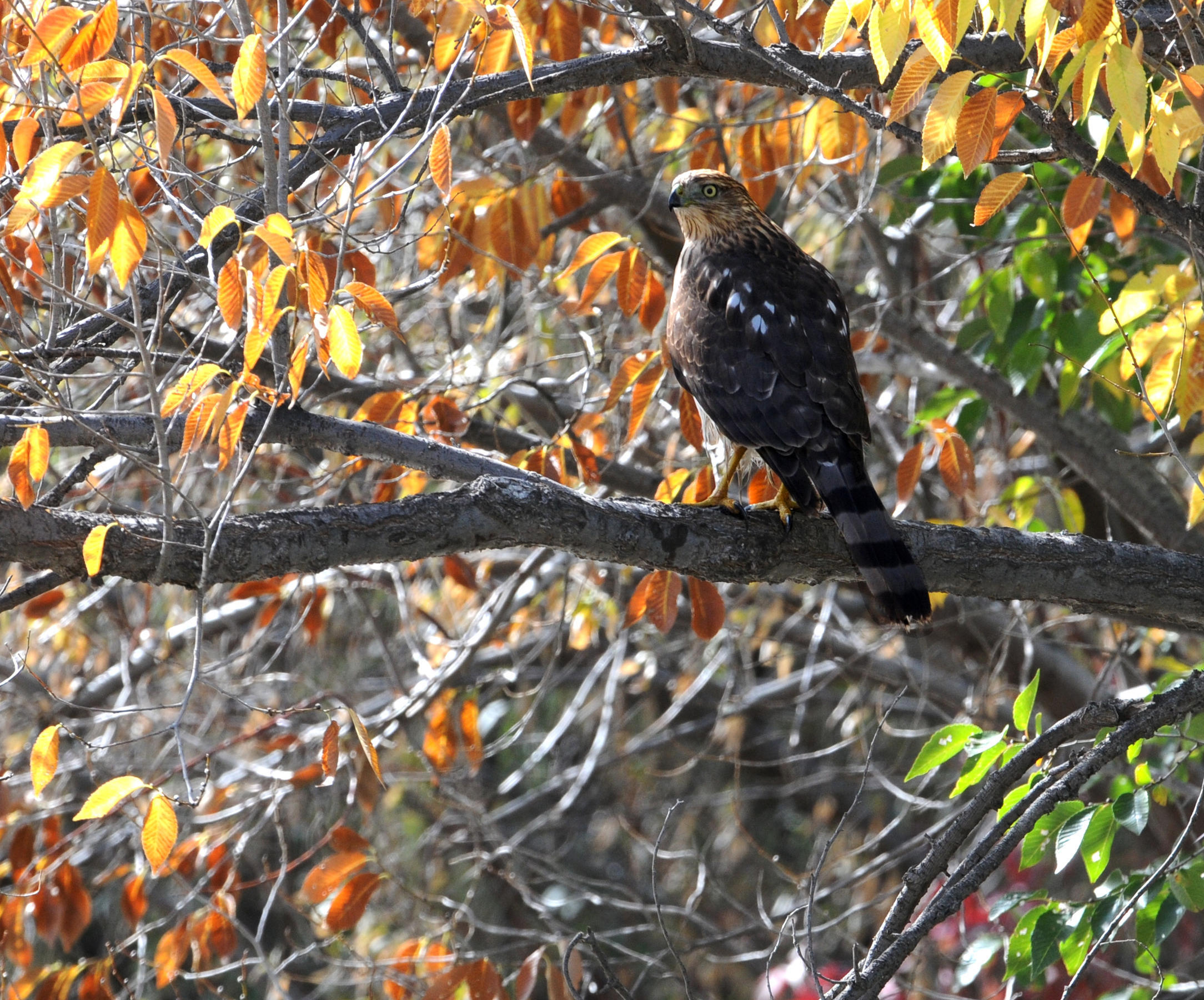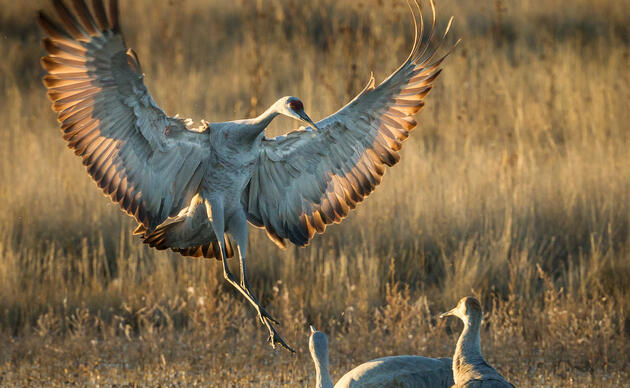The Corrales Bosque Preserve and the Lower Rio Grande Bosques IBAs protect riparian habitat, which is particularly important for avian communities in the arid Southwest. Even though riparian areas comprise less than 1% of the landscape in New Mexico, they provide habitat for more bird species at some time during the year than all other vegetation types combined, including habitat for breeding species, stopover habitat for migrants, and habitat for winter resident and winter migrant species.
It is important to remember that identifying an IBA is just the first step in the process of ensuring that these areas will provide long-term protection for birds and are more than dots on a map. Audubon members, hard-core birders and casual bird lovers can all play a key role in “adopting” these important areas by engaging in a variety of activities that support them, including participating in bird surveys, assisting with restoration efforts, monitoring sites for new threats, hosting bird education programs, and providing advocacy in their protection.
Corrales Bosque Preserve IBA
The Corrales Bosque Preserve, within the Middle Rio Grande, is 662 acres in a narrow strip of relatively natural riparian habitat located on the west side of the Rio Grande within the territorial limits of the Village of Corrales, north of Albuquerque. The predominant habitat is forested riparian composed of Rio Grande cottonwood with an understory of New Mexico olive, Goodding’s willow, and coyote willow. The Preserve includes important shrubby habitat in forest openings and along the river edge, levee, and drainage canals. A recent restoration project conducted by the U.S. Army Corps of Engineers (USACE) added valuable willow swale habitat and planted native trees, shrubs, and grass in the southern portion of the Preserve. The project also focused on treatment and removal of exotic plants.
More than 250 bird species have been observed in the Preserve, which provides valuable habitat for many breeding, migrating, and wintering birds. In a study of avian communities at sites within the Middle Rio Grande, Hawks Aloft found that the Corrales Bosque Preserve supported some of the highest species densities and numbers of species in both summer and winter. It hosts high abundances of two breeding species identified as priorities by New Mexico Avian Conservation Partners – Black-chinned Hummingbird and Summer Tanager. The Preserve also has the highest documented density of nesting Cooper’s Hawks in North America.
Other common breeding birds in the Preserve are Gray Catbird, Yellow-breasted Chat, and Black-headed Grosbeak. Some of the more abundant spring or fall migrants include Warbling Vireo, Orange-crowned Warbler, Virginia’s Warbler, MacGillivray’s Warbler, Wilson’s Warbler, and Western Tanager. In winter, Sandhill Crane occur in high numbers.
The land in this IBA is managed by two entities through a Joint Powers Resolution. The Middle Rio Grande Conservancy District (MRGCD) has ultimate management authority over the land, and maintains the levees, ditches, and drains in the Preserve. The Village of Corrales is responsible for the management of the Preserve, which was dedicated in 1986. The Corrales Bosque Advisory Commission advises the Village Council and developed the Corrales Bosque Preserve Habitat Management Plan in 2009. Both MRGCD and the Village Council unanimously supported the nomination of this IBA.
The management plan makes recommendations regarding conservation issues facing the Preserve, which include exotic plants, hydrologic changes, protecting preserve habitat and the community from fire, and habitat and wildlife disturbance. The existence of historical and long-term monitoring data from the Preserve will help inform future management of the IBA. These include data from a Middle Rio Grande-wide monitoring project in the 1980s, and from a monitoring program conducted by Hawks Aloft since 2004 and funded by USACE. These data will allow documentation of changes in avian communities over time.
Lower Rio Grande Bosques IBA
The Lower Rio Grande Bosques IBA encompasses 7,000 acres which include lands in Mesilla Valley Bosque State Park (MVBSP), Leasburg Dam State Park (LDSP), Broad Canyon Ranch and Selden Canyon, along with 4,800 acres of public land grazing allotments. The state park properties contain some of the best remaining wetland and riparian habitats along the lower Rio Grande in Doña Ana County. Selden Canyon, from Tonuco Mountain through Radium Springs, is the only lengthy reach along the lower Rio Grande that is not channelized. Native vegetation found in different areas of the IBA include salt grass, Rio Grande cottonwood, coyote and Goodding’s willow, hackberry, screwbean and honey mesquite. In particular, the cottonwood/willow and mesquite bosque habitat that is found in these areas in the lower Rio Grande are the last remaining examples of this kind of habitat anywhere south of Percha Dam State Park in New Mexico. For this reason, the primary value of this IBA is that it qualifies under the criterion of “rare, unique, or representative habitats.”
The other important criterion for the identification of this IBA is that these remnant bosque habitats maintain at least 1% of two state endangered or threatened species, the Bell’s Vireo and Southwestern Willow Flycatcher, the latter of which is also a federally threatened species. Selden Canyon is home to the Rio Grande’s southernmost breeding population of Southwestern Willow Flycatchers, and breeding has been documented there for Bell’s Vireo as well. Other breeders in Selden Canyon include Golden Eagle, Yellow-billed Cuckoo, Lucy’s Warbler, Summer Tanager, Painted Bunting, and Bullock’s Oriole. Significant riparian breeders at MVBSP also include Lucy’s Warbler, Summer Tanager, and Bullock’s Oriole. These lower Rio Grande bosques are also extremely important for many migrants, such as Wilson’s Warbler. Native wetland habitats have all but disappeared along the lower Rio Grande, so the natural and man-made wetlands at MVBSP and in Selden Canyon are valuable to many marsh and open water species including herons and waterfowl. Almost 350 bird species have been documented by the Mesilla Valley Audubon Society in the riparian corridor of Selden Canyon and the Northern Mesilla Valley, and bird lists for MVBSP and LDSP include more than 250 species.
Though ownership of the land in this IBA varies, the state park lands are managed by New Mexico State Parks, enabling ongoing habitat restoration (including removal of non-native salt cedar) and planning for future conservation, research, and educational programs. Public access is restricted at Camp Robledo at LDSP, however special birding events occasionally take place on this property. Public access is also restricted at Broad Canyon Ranch; please contact the San Andres National Wildlife Refuge. Note that there is private land within Selden Canyon, so please respect the boundaries of these private properties.
How you can help, right now
Join the Western Water Action Network
Receive action alerts about water issues, and issues that are affecting birds across the arid West.
Donate
Help secure the future for birds at risk from climate change, habitat loss, and other threats. Your support will power our science, education, advocacy and on-the-ground conservation efforts.
Nina Mason Pulliam Rio Salado Audubon Center
Visit the Nina Mason Pulliam Rio Salado Audubon Center in Phoenix, Arizona.




